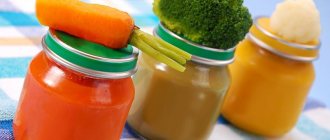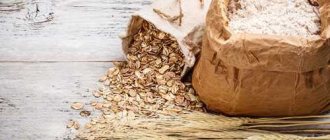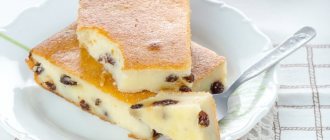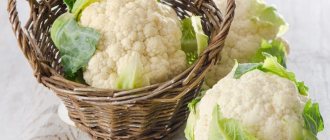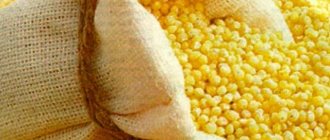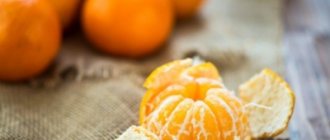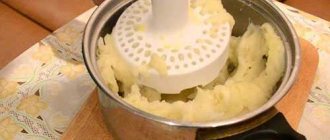Porridge is the basis of nutritious baby food. They are the main source of healthy carbohydrates, vegetable proteins, and B vitamins. For example, buckwheat porridge can completely provide the baby’s body with iron. It is recommended to introduce porridge as the first complementary food at the age of 5–6 months, but if the child is overweight, then these products should be given as a second complementary food after getting used to vegetable purees. They are introduced gradually, starting with a liquid consistency, through the nipple. Within 5–7 days, bring to normal consistency and required volume.
Advantages of industrially produced porridges
Documentation from 2002 from the World Health Organization notes that commercially produced cereals should be used for the first complementary feeding, as they have a number of advantages:
- additionally enriched with iron, calcium, zinc and iodine;
- do not require cooking;
- easy to digest;
- have a homogeneous consistency and do not thicken when cooled;
- do not contain salt, GMOs, dyes, artificial additives, made from safe raw materials;
- undergo multifaceted quality control;
- The cereals are prepared using enzymatic hydrolysis, which increases their natural sweetness and reduces viscosity, thereby making them easier to swallow.
When buying porridge intended for baby food for your child, you can be sure that it is made only from natural and pure raw materials and does not contain heavy metal salts or foreign impurities.
Rice porridge for first feeding
This cereal contains a lot of starch, but, nevertheless, is perfectly absorbed by the child’s digestive system. Rice cleanses the intestines and removes excess salts from the body. It is beneficial for the nervous system.
But there is one drawback here: rice porridge is strong, so it is not recommended for children prone to constipation . You should also avoid rice cereal if you have diabetes and are gaining weight too quickly.
Porridge for first feeding
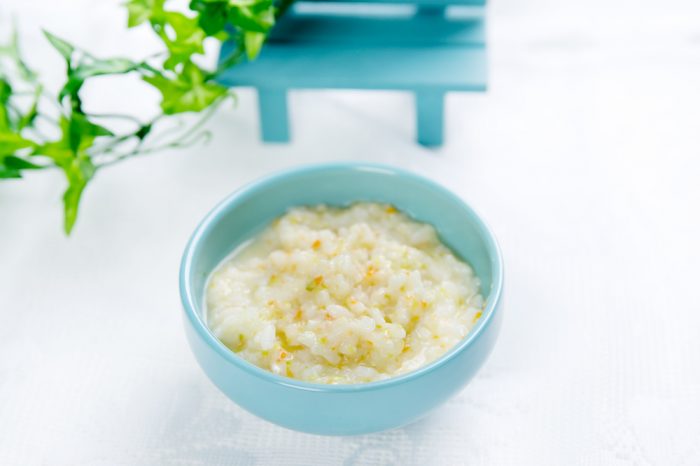
Porridge for first feeding should not contain gluten. The ideal option is buckwheat, rice or corn porridge.
For the first complementary foods, it is recommended to use gluten-free cereals - rice, buckwheat, corn. It is advisable to administer rice to children with frequent, loose stools, as it strengthens, while buckwheat is preferable to children with low hemoglobin levels. If the child does not have one or the other ailment, then you choose at your own discretion and taste which of the three porridges to give to the child.
On a note! Recommendations from the country's leading pediatricians:
- first porridge (4–5 months) – rice, buckwheat;
- then (5–6 months) corn, corn + buckwheat, corn + rice;
- only then (6.5–7 months) can oatmeal, semolina, millet and oatmeal be introduced;
- Porridges made from 3 or more grains are allowed no earlier than 7–7.5 months.
- from 7.5–8 months, you can give multi-component cereals with the addition of fruits and dried fruits, and when the child begins to chew well, you can give cereals with pieces of fruit.
We begin to introduce different cereals at intervals of 5–7 days.
As a pediatrician, I recommend starting complementary feeding with dairy-free porridge in order to prevent allergies. If a child has normal or even overweight, then it is better to cook with water. This will help form the right taste and will not lead to unnecessary kilograms. When the child begins to refuse such porridge, it means it’s time to switch to milk porridge.
Buckwheat porridge for first feeding
This cereal is the least likely to cause allergies in infants; it has a beneficial effect on digestion and is very nutritious. Buckwheat porridge will provide the baby with the necessary amount of B vitamins, potassium, phosphorus, and magnesium.
Buckwheat contains iron, so it is recommended to give it to those babies who have low hemoglobin. In a word, this is an ideal start to complementary feeding - the only problem is that not all children like its taste and often the baby turns up his nose at the plate and flatly refuses to try at least half a spoon. There is no need to insist, because there are two more excellent options for the first feeding.
There are porridges:
- Dairy and dairy-free. Dairy-free porridge is cheaper than milk porridge, does not contain sugar, it is recommended to give it to children with intolerance to cow's milk protein, children with food allergies, or if the mother decided to prepare porridge with breast milk, a special medicinal mixture. Milk porridges are much tastier and more aromatic, they contain sugar, and children eat them much better.
- Gluten-free (rice, buckwheat and corn), gluten-containing (semolina, millet, oatmeal and oatmeal). Gluten-containing cereals are not recommended as first complementary foods for the purpose of primary prevention of hereditary disease of the small intestine - ciliacia.
On a note! Gluten is a plant protein, otherwise called gluten, present in many cereal plants.
- Single-component (from one grain), multi-component (from 2–8 grains), with the addition of fruits, dried fruits, vanilla, chocolate, honey, nuts and seeds.
- There are a number of hypoallergenic cereals. They are mostly dairy-free.
- Sour-milk porridges are delicious and very suitable for variety when the child has already tried everything.
- Helpful porridges have been developed especially for children over 8 months of age. They have a more complex consistency, contain pieces of fruit, pro- and prebiotics.
The porridge options are:
- Drinking porridges (for example, from “Semper”, “Karapuz”).
- Instant cookies (“Hipp”, “Heinz”, “Confit”). Its properties are very close to porridge.
- Muesli with pieces of fruit. Allowed to be given to children from 9–10 months, a wide range from. They help the child quickly master the skill of chewing.
Corn porridge for first feeding
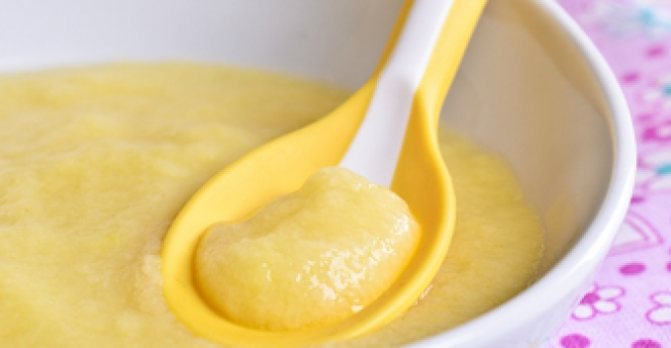
Despite the fairly high starch content, it perfectly normalizes digestion, preventing both constipation and diarrhea. For many kids, this particular porridge becomes their favorite from the first try. Substances contained in corn stimulate the growth of muscle tissue and strengthen blood vessels. In addition, it is low in calories and very rarely causes allergies.
Children's doctors recommend starting with buckwheat porridge, without milk and without sugar. But it may contain fruits that the baby has already tried - apple, pear, apricot. Then rice is introduced, and finally corn. But this is not a strict scheme; deviations are possible if the baby does not like the taste of a particular porridge. Perhaps later he will taste it and eat it with pleasure.
How to properly prepare porridge for a small child?
There should be no problems when using industrially produced cereals for baby food; the preparation method is always indicated on the packaging. Typically, the dry product is poured with boiled water/prepared mixture/milk (temperature 45–50 degrees) and stirred until completely dissolved. Prepared immediately before use.
If you use regular cereal porridge for your child, then you need to boil it well in water, and then add breast milk or formula to the finished porridge at the rate of 75 ml of milk/mixture per 100 ml of porridge. You can add 5 g of butter or vegetable oil.
If you use cereal flour to prepare porridge, then you need to dilute it with cold water, and then pour it into the boiling mixture/milk, cook for 3-5 minutes.
How to prepare baby porridge for complementary feeding?
Today there is no shortage of ready-made infant formulas from a variety of manufacturers. It is very convenient to buy a pack of the desired porridge and cook exactly the amount that is required. But pediatricians recommend cooking it yourself if possible, although this is troublesome - after all, baby food cannot be stored for future use and reheated; each time the baby should be given only a freshly prepared dish.
If you decide to cook your first porridge yourself, do it like this:
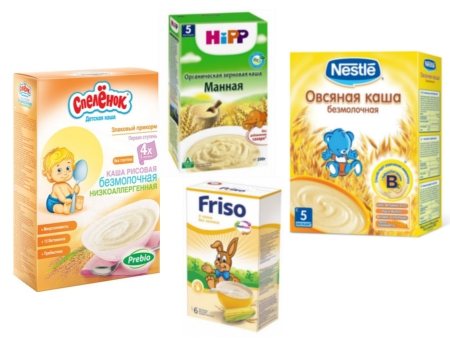
Wash a handful of cereals and dry them on a plate or board.- Place in a coffee grinder or blender and grind, but not into flour, but into coarse crumbs - then the porridge will cook faster.
- Place a baby saucepan on the fire - the infant should have its own separate dish, pour some purified water into it and let it boil.
- No spices, salt, sugar or milk are added to the water! After cooking, you can flavor the dish with a few drops of vegetable oil or breast milk.
- The ground cereal is slowly poured into boiling water and immediately stirred in a circle so that no lumps form.
- Cook the porridge over low heat until fully cooked, then remove from the heat and wrap warmly.
- After 15 minutes, if necessary, the dish is further ground in a blender - you should get a liquid porridge of uniform consistency, not the same as for adults . Now the baby can try it and discover a new taste.
Later you can add butter, boiled carrots or zucchini, cauliflower, apple, pear, dried fruits or wild berries. You can also prepare mixed porridges. But remember: only those products that he has already tried can be mixed in the baby’s plate, and they have not caused allergies or digestive upset.
Larisa Tokareva, pediatrician
6, total, today
( 176 votes, average: 4.48 out of 5)
Umbilical hernia in children: symptoms, treatment, indications for surgery
Myopia in children: causes of myopia, its treatment and prevention
Related Posts
Porridge producers
There is a huge selection of baby cereals for first feeding on the market. We will inform you about the most common brands:
- "Baby." A small assortment, literally 10 types of dairy and dairy-free porridges.
- "BelLact". A large assortment of dairy-free and milk porridges. Muesli and porridge with pieces of fruit are not on sale yet.
- "Vinny." Standard small assortment of cereals.
- "Karapuz." There is a lot to choose from, mostly porridges are created with additives from fruits and berries, the manufacturer regularly introduces vitamins and minerals into the composition.
- "Little one." Porridges are suitable for first feeding, as they are mainly made without the addition of berries, fruits and vegetables.
- "Nestlé". It should be noted that the porridges are well digestible and have a very pleasant taste. Children refuse to eat simple cheap porridge after using them. A very rich assortment: from hypoallergenic porridges and porridges for the little ones to “helpers” and “steppers”. They have a variety of flavoring additives (even linden blossom), an assortment of fermented milk porridges and yoghurt porridges, and there is even an anti-reflux porridge.
- "Nordic". Expensive cereals, but the packaging is large. There is nothing special for first feeding, but they have a huge assortment of cereal flakes, which is good for children older than one year.
- "Nutrilon". The manufacturer is trying to maintain the brand on the market, so the range is good and interesting; there are cereals with the addition of cookies, which is very good for small children.
- "Semper." The manufacturer has porridges for any age up to 3 years, and has divided them specifically into higher-calorie morning and lighter evening cereals, which are respectively named “Good Morning” and “Good Evening.” There is a special line of cereals - “Nutribalance”. The porridges are tasty and mostly milk-based, but they are not for first feeding.
- "Frutonyanya." Porridges of this brand are recommended by the Union of Pediatricians of Russia. There are porridges for first feeding; the assortment includes 4 types of porridges enriched with inulin.
- "Heinz". A conscientious manufacturer who took care of both the little ones, providing an assortment of cereals for the first feeding, and for older children.
- "Hipp." The assortment is small, but there are porridges for first feeding, porridges for the night and those containing prebiotics.
- "Humana." There are cereals available for first feeding, but the range of dairy-free cereals is scarce. The manufacturer has taken care of older children and produces porridge with the addition of crackers and biscuits.
Not all parents can afford Nordic and Semper porridges; porridges and Heinz are also among the most expensive; Baby, Vinnie, Malyutka and Frutonyanya are a little cheaper, and the inexpensive BalLakt.
Feed your baby only freshly prepared porridge. The porridge cannot be reheated; it must be served fresh and warm.
Ideal cereals for complementary feeding
Corn, rice and buckwheat are gluten-free porridges. For the first feeding, you can choose any of them. Since buckwheat is considered the queen among porridges, it is better to opt for it. Judge for yourself, this cereal is rich in B vitamins and microelements: iron, magnesium, phosphorus, silicon. In addition, buckwheat contains a lot of protein. And all these components are simply irreplaceable for proper nutrition of the baby. Buckwheat is an environmentally friendly product, since the cereal crop buckwheat (from which cereal is made) grows in domestic fields and does not require special treatment with various drugs against weeds and pests. In addition, many mothers note that babies eat buckwheat porridge with pleasure and love it.
Many babies also love corn porridge. It tastes good, and its bright yellow color attracts the attention of children. It is worth noting that this cereal is not as rich in various vitamins as buckwheat, but it also has something to boast about. The composition of corn grits includes vitamins A, B, PP, microelements: phosphorus, potassium, sodium. The main advantage of this yellow porridge is fiber. Such dietary fiber has an excellent effect on intestinal function and helps strengthen the immune system, which is extremely important at any age.
Rice porridge is one of the champions in the content of complex carbohydrates, which provide the body with the necessary strength and energy. It also contains B vitamins, potassium, magnesium, and iodine. Young mothers, when choosing rice porridge for the first complementary feeding, should take into account that it can cause constipation in the baby if he has digestive problems.
Regardless of which porridge a woman chooses for her first complementary feeding, she must remember that she should start introducing the product with one teaspoon per day. Then you need to increase the dose daily, and after a week the baby can be given 100-150 grams. Any new complementary foods, including porridge, should be introduced in the morning. Thus, the mother will be able to monitor the child’s body’s reaction to the new product. In addition, it is important that porridge for the first feeding should be without various additives: honey, nuts, fruits. This is necessary for two reasons. Firstly, the baby should be introduced to the “pure” taste. Secondly, you cannot overload the child’s body with several components at once when the mother introduces the first complementary foods. Porridge with additives can be given when the baby is 9 months old. Then his body will be completely ready for the extravaganza of tastes.
Types of cereals for complementary feeding
Porridge is considered a very important and necessary product in baby food.
- It is very rich in microelements and has a good effect on the baby’s digestive system;
- It contains B vitamins, carbohydrates and protein.;
- Cereals are a source of carbohydrates that provide energy to a small body. They have high nutritional value and contain many useful nutrients that are necessary for a growing body.
Porridge can be introduced into a child’s diet as early as 6 months.
If you are going to introduce complementary foods with store-bought cereals, then you should know the following. There are several types of store-bought complementary feeding cereals:
- dairy-free and dairy-free;
- gluten-containing and gluten-free;
- multi-component and single-component;
- hypoallergenic and fermented milk.
Therapeutic and prophylactic porridges, which contain pro and prebiotics, are also sold. This product restores the balance of intestinal microflora.
- Start complementary feeding with store-bought food, preferably cereal without milk. Cow's milk is currently considered the No. 1 allergen.
- Choose one-ingredient dairy-free cereals for your first complementary feeding. They must not contain gluten, starch, sugar or other additives.
Most often, complementary feeding is started with buckwheat and rice porridge. After the baby gets used to these dishes, his diet can be expanded with corn and wheat porridge.

